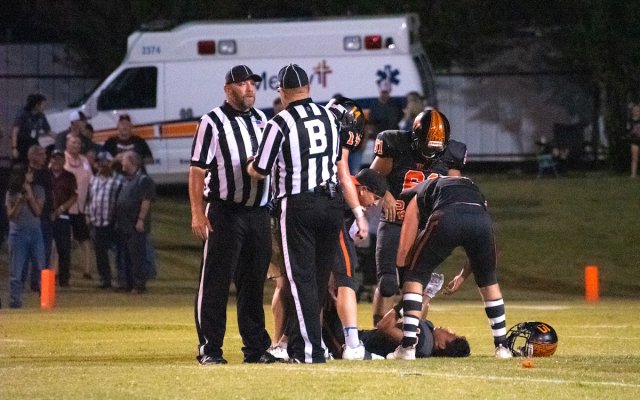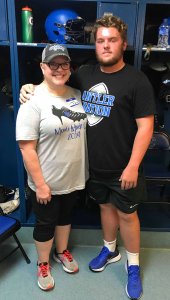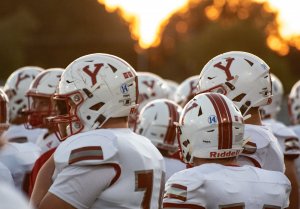
Rep. Mickey Dollens (D-OKC) vividly remembers his early days playing football as a kid growing up in Bartlesville.
Dollens started playing tackle football in seventh grade after a couple of seasons of the flag version. It was a rude awakening.
“We hit, and we hit hard,” Dollens said.
Practices in high school included drills meant to test the mettle of players.
“We would have this drill we called a ‘Stymie drill’ where we would line up about 10 yards away from each other and run at each other as hard as we could,” Dollens said. “Whoever was stymied basically lost. So if we were running at each other and my momentum carried my body through yours and you ended up on the ground, you lost.”
Dollens mastered those moments, dishing out punishment every time. He obliterated so many opponents in the drill that his teammates took notice and developed a name for his devastating blows.
“It became when someone would get concussed, knocked out and fall to the ground,” Dollens said. “I would do it so often, it became named after me, Mickey: a McNasty.”
But Dollens’ football days aren’t some throwback to leather helmets, Bear Bryant and the Junction Boys. He’s just 32, and while his high school years are in the rear-view mirror of his new life in politics, they aren’t quite ancient history.
Little more than a decade later, the football culture around how players practice and hit each other has changed.
‘We’re trying to make it safer because we want football to stay around’
Today, high school coaches in Oklahoma must limit “live” practices where players are in full pads and hit at full speed to just 90 minutes a week. The reduction comes from a recommendation by a National Federation of State High School Athletic Associations task force on concussions that the Oklahoma Secondary Schools Activities Association has adopted. The limited practice time is intended to reduce injuries in the sport, and it was implemented as the culmination of a thought process that had been ongoing in coaching circles for years.
Kingfisher High School coach Jeff Myers served on the NFHS concussion summit task force. An award-winning coach, Myers said his experience at the 2014 summit was eye opening and reinforced his belief that too much contact did not serve players’ or teams’ long-term goals.
“We had already made the adjustment long before the 90 minutes came up,” Myers said of his own squad. “It’s been a long-term move toward tweaking our practice habits.”
Myers has coached at Midwest City, Edmond Memorial and Woodward, among other stops. Kingfisher won a state championship in 2013 with a 15-0 record. The Yellowjackets have evolved into one of Class 3A’s best programs under his watch.
Myers said the evolution of thinking on practices represents a drastic turn from his playing days three decades ago.
“We had no limits when I went to school in the 1980s,” Myers said. “Zero limitations on contact. The action type stuff was far greater then than it is now.”
Even when there is contact now, Myers said coaches take a high level of caution.
“We rarely go live,” Myers said. “When we do, it is heavily controlled. Quick whistles. We don’t take guys to the ground.”
Myers said he has heard no objections from other coaches about limiting contact to 90 minutes per week, which does not include games.
“Coaches don’t want to go out and have their guys beat the hell out of each other running Oklahoma Drills,” Myers said, referencing a high-impact, short-space drill seen in the 2014 Wewoka High School video below.
The goal behind initiatives like the 90-minute rule and advanced concussion protocols is to help preserve the game. Nationally, participation in high school football fell 3 percent last year.
“We’re trying to make it safer because we want football to stay around as long as we can,” Myers said. “We want to preserve the sport. With that comes changes, safer practices and better equipment.”
Parent: ‘I worry about that and everything else’
Like thousands of parents of Oklahoma high school football players, Lorrie Bamford loves cheering for her son, Aaron Corbin, and his Deer Creek teammates on fall Friday nights. And, like most parents, she worries her son is going to get hurt.
For good reason. A senior, Corbin tore an MCL last year, forcing him to miss a huge chunk of his junior season.

To her knowledge, Bamford said her son has not sustained a concussion playing sports, but she is aware of the risk thanks to increased public discussion of CTE and head injuries in football.
“My awareness has heightened since his injury,” she said. “There is an entire spectrum of things that can happen. Even at a position like his where he doesn’t take a lot of blows to the head, I worry about that and everything else.”
Some of those fears are eased by the resources devoted to safety at Deer Creek. The school has a physician on the sidelines during games along with a certified athletic trainer and student assistants who provide extra sets of eyes.
Efforts at augmenting safety are communicated to parents via email, as was the case when the school began testing for concussions electronically. Bamford received a detailed email on how the testing would work.
“It makes me a lot more comfortable as a parent,” she said. “It doesn’t mean I worry less, but I know if something happens there will be immediate attention.”
Bamford also knows many schools don’t have those resources.
“I thought that was the standard,” she said. “But I’ve since learned it’s pretty unusual to have that level of observation.”
Doctor: ‘Parents sometimes really enable this’
To diagnose and treat sports-related concussions well, players must be up front about what they are experiencing. In youth and high school athletics, parents also must prioritize their child’s welfare over competition.
Unfortunately, that doesn’t always happen. Neurologist Dr. Jaclyn Duvall has worked with post-concussion patients and has seen the spectrum of parental reactions.
“I hate to say it, but parents sometimes really enable this,” she said. “I can’t tell you the number of times parents come in and they tell me, ‘He’s got to get back out here. This is his entire life. He has to do this.’ And I see this and I go, ‘This may change his entire life for the next five decades,’ but yet we’re talking about the next two years (for sports).”
While most parents are proud of their child’s accomplishments, sometimes that pride can get in the way. Duvall finds that even horror stories have little impact.
“With these patients, I actually try to avoid stories with the parents because every parent thinks their child is different and unique,” she said.
Those traits aren’t only found in the parents. Some kids simply want to play through any injury. Sometimes that’s because they love the game, or they don’t want to let their teammates down, or because so much of their identity is tied up in their sport. Some will say anything to get back on the field or court.
“Whenever I see a patient, I have to look at what their motivation is,” Duvall said. “Sometimes I hear them say, ‘I’m fine, I’m fine.’ But I do some vestibular ocular testing, and they are not fine. They are still symptomatic.”
Bamford said she isn’t sure how up front her son would be about a concussion if he had one.
“If I’m being completely honest, I don’t think he would tell me because he loves the game so much,” Bamford said. “But after the game, and after that adrenaline rush goes away, I could see him saying he has a headache once you get him outside of the moment.”
OSSAA’s David Jackson recalls his football days
Growing up in Pauls Valley, David Jackson never had much idle time on his hands thanks to sports.
“You played whatever was in season at the time,” Jackson said. “You didn’t specialize.”

Football practices were for those who wanted to hit hard and could take a beating.
“The very first drill that you did when you put on the pads was the Oklahoma Drill, and you tried to knock people out,” Jackson said. “It was the drill, at least in Pauls Valley, to weed out those who weren’t tough enough to play football.”
Today, Jackson serves as the executive director of the Oklahoma Secondary School Activities Association, which governs the state’s high school athletics.
But before he got into the administrative end, Jackson coached high school football at Pauls Valley for five years. When he thinks about head injuries he has seen first hand, a 1987 semifinal football game stands out.
“One of my receivers came off the field, and he looks me in the eye,” Jackson said. “I give him a play, and he has no idea what we’re talking about. I give him the play again, push him out there, he gets about half-way out and he falls down.”
The player had been badly concussed, so much so that he was transported to a hospital. Jackson said the moment highlights how much things have changed when it comes to managing head injuries.
“Stupid David is trying to get him back in the game because we needed him,” Jackson said. “That’s what you did.”
Now, Jackson said the OSSAA is focused on increasing concussion awareness and working to limit risk in the inherently dangerous game of football. He said most Oklahoma coaches are completely on board.
“When we have to implement something like we did with football (practice time) that involves reducing risk, we’ve had very little pushback,” Jackson said. “Even some of the old guard that probably did this Oklahoma Drill throughout most of their career, once they become aware of the studies, the effects of their teaching techniques and how it could affect the long-term health of students, I do firmly believe that 99 percent would place that long-term health of their kids above their passion for winning.”
Jackson, who just finished a term as NFHS president, said it wasn’t very long ago that some coaches withheld water during practice as motivation. Football culture, he said, is changing.
“Believe me, we’ve got some that would want to win almost at any cost,” Jackson said. “But I would tell you that even the most aggressive coaches in terms of winning, once they’re informed and once they’re educated to the long-term effects of their teaching techniques, I would be surprised if you found any that wouldn’t be willing to change how they do things if it helped keep a kid safe and had a positive impact on their long-term health.”
Violence falling out of fashion at many levels of football culture
That these conversations even take place represents an advancement in how Oklahoma’s athletic culture is thinking about concussions and the violence in football. Likewise, there have been subtle changes at other levels of the game.
RELATED
Revisiting the science of sports-related concussions by Dr. Ashiq Zaman
Long a staple of NFL highlight shows, the devastating hits that drew viewers are mostly gone now. In the aftermath of a class-action lawsuit settlement that featured more than 20,500 members, the NFL has invested millions in promoting safer football across all levels through its Play 60 initiative. Graphic injuries are shown with less frequency during game broadcasts.
“The fact those highlight reels aren’t around anymore shows a little bit of how the public perception has changed,” former University of Oklahoma tight end Trent Ratterree said.
Looking back on the punishment his own body took during his football career in high school and at OU, Ratterree questions the value of fans seeing those hits in the first place.
“They’re vicious, violent hits,” he said. “I think people who get a kick out of that have never done it. They’re never received that hit or delivered that it. They’ve never hit someone and felt their bones crack. If they had, they might have a different perspective.”
Ratterree pauses, before boiling it down.
“The game can be enjoyed without seeing people getting their heads knocked off,” he said.
More #concussion coverage
The hazy, frightening world of a sports concussion
Lacking data, Oklahoma high school concussion picture blurry






















